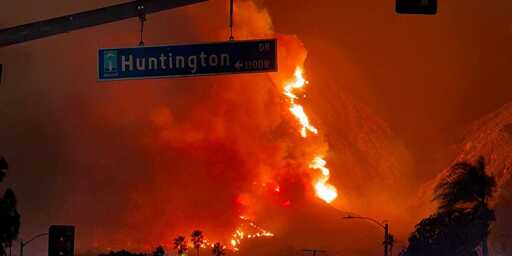To all my homies that get the popup on mobile:
The policy debate over climate change never stops, so when Los Angeles caught fire a few days ago, the finger pointing over who or what to blame quickly followed. I thought it would be helpful to write a quick post telling you what the science tells us about the connection of these fires to climate change. What are the ingredients of a devastating fire?
Fires like the one in LA emerge through a sequence of climatic events:
The cycle typically begins with periods of significant rainfall, which promotes vegetation growth and biomass accumulation: in Los Angeles, they had an incredibly wet 2024 winter.When this wet period is followed by prolonged dry conditions and elevated temperatures, the accumulated vegetation dries out, turning it into rocket fuel for a wildfire: in Los Angeles, they had an incredibly dry and hot summer 2024, and basically no rain since.
Finally, you add an ignition source and strong winds to spread the resulting fire: There are always ignition sources, both human and natural, that start the fire. Santa Ana winds spread the fire, and made it basically impossible to fight.
How is climate change affecting fires like the one in Los Angeles
Climate change doesn’t cause any of these factors. But climate change can affect them. For example, we are confident that climate change is making rainfall more variable, with bigger swings from wet to dry extremes. This promotes vegetation growth and then drying it out. Additionally, humans are also causing a warming of the climate system, which accelerates the drying of vegetation by increasing evaporation rates and extending drought periods.
In this way, climate change is turbocharging the wildfire just like it turbocharges heat waves and hurricanes.
Of course, other factors also play a role, such as the amount and arrangement of available fuel. Forest management practices over the past century have led to accumulations of understory vegetation and dead organic material in many forests. The expansion of cities into wildland areas introduces more potential ignition sources, adds structures and infrastructure that can fuel fires, and creates zones where preventive measures like prescribed burning are challenging to implement.
Climate misinformers often exploit these multiple contributing factors to downplay climate change’s role. They present a false, illogical choice: “If poor forest management is to blame, then climate change can’t be playing a role.” The best available science tells us otherwise — climate change’s influence on fire behavior has grown increasingly significant in recent decades, amplifying the effects of any management decisions or human development patterns. In the media …
Unfortunately, many media outlets continue to rely on outdated scientific caveats about linking extreme weather like this wildfire to climate change. Link
Climate change does not “cause” extreme events, but it can amplify them. In fact, it is certain that climate change affects every weather event by altering the baseline conditions in which they occur.
Thus, the real scientific question is not whether climate change influenced the fire — of course it did. Rather, the real question is quantifying the impact: how much did climate change increase this specific event’s intensity or likelihood? We don’t know the answer yet, but I’m sure scientists are already working on it.
When reporters frame the issue as one of uncertain causation, they’re misrepresenting the science and giving climate misinformers room to cast doubt where none really exists. The recovery
Recovering is going to be really, really hard. One aspect that I think about a lot is how bad this is going to be for housing availability. When Paradise, CA burned in 2018’s Camp fire, roughly 50,000 people were displaced. About 15,000 relocated to nearby Chico — a city already struggling with a severe housing shortage.
This sudden population surge triggered multiple waves of housing instability: wealthy fire survivors quickly bought up available homes in Chico, causing housing prices and rents to spike; landlords in Chico evicted their residents so they could sell their properties in the booming market; and those who couldn’t afford the inflated prices ended up homeless. While fire survivors received some disaster assistance, those indirectly displaced by the resulting housing crunch got no help.
The crisis exposed how climate disasters can amplify existing housing vulnerabilities — Paradise had historically served as a destination for people priced out of Chico, and its destruction eliminated that crucial safety valve, leaving many with nowhere affordable to go. This fire will be bad news for the LA housing market.
If you want to learn more about the housing problems that followed the Camp fire, listen to this episode of 99% Invisible, one of my favorite podcasts1. The stories of people displaced and unable to find housing in that episode are heartbreaking. Insurance
I find myself talking incessantly to anyone who will listen that home insurance is becoming a climate-fueled catastrophe. For example, here’s a Climate Brink post about it.
Insurance companies are already reducing their exposure to risk in California and there’s absolutely no doubt that this event is going to make it both harder and more expensive to get insurance there. This is also happening in Florida because of hurricane risk.
Rising insurance costs may ultimately make it too expensive for many people to stay in their homes. In places like California and Florida, this is forcing residents to go without coverage, accept bare-minimum policies that don’t actually cover recovery costs, or pay astronomical premiums that consume an ever-larger share of their income.
The ripple effects extend far beyond individual homeowners — without affordable insurance, businesses struggle, property values decline, local tax bases erode, and entire communities can face economic instability. This insurance crisis represents one of the first ways that climate change is systematically harming economies, long before the physical impacts of warming fully materialize. A final thought
I’ll leave the final thought to a friend who lives in LA, who wrote this in an email:
This is a catastrophe on a scale that is difficult to imagine, even if we scientists know the statistics increasingly favor these scales of destruction.Removed by mod
to use these fires as a debate point in the realm of climate change is cheap and stupid.
Last year and the year before there were extreme fires all over North America. How many do we have to see before it becomes reasonable to refer to them in a debate about climate change? The way a general trend manifests is in particular events. There isn’t really a way to draw attention to it except by referring to those particular events.
Removed by mod
… but if they’re caused by something else then? Not everything is due to climate change. In this case there’s plenty of science done on how our forest management causes these extreme fires.
Sure, the are many variables. The problem is that those events (big fires, big hurricanes, big floods etc), those “once in a lifetime” events are now happening more often.
Did you read the paper?
Over a human lifespan, the modeled impacts of the suppression bias exceed those from fuel accumulation or climate change alone, suggesting that suppression may exert a significant and underappreciated influence on patterns of fire globally. Managing wildfires to safely burn under low and moderate conditions is thus a critical tool to address the growing wildfire crisis.
The paper says that management techniques are a significant factor, alongside fuel accumulation and climate change. As the person you’re responding to says, there are several contributing factors, a significant one of which is climate change. The paper you point to doesn’t disagree with this.
We can’t approach these events with a black-and-white question, “Is it due to climate change or not?” We know that climate change increases the likelihood and severity of some extreme weather events, floods and forest fires. We know that other factors also influence these things. Usually all you can conclude about a particular fire, storm or flood is that climate change made such events more likely and raised the chances of them being severe. Other factors are always at work too. It’s not realistic, for the most part, to look for particular incidents that are caused by climate change only.
Yes, as you quoted, forest (mis-)management is a bigger factor than climate change.
Now check the claims made in what we’re discussing.
Now check the claims made in what we’re discussing.
OK. The article says:
Climate change doesn’t cause any of these factors. But climate change can affect them. For example, we are confident that climate change is making rainfall more variable, with bigger swings from wet to dry extremes. This promotes vegetation growth and then drying it out. Additionally, humans are also causing a warming of the climate system, which accelerates the drying of vegetation by increasing evaporation rates and extending drought periods.
In this way, climate change is turbocharging the wildfire just like it turbocharges heat waves and hurricanes.
Of course, other factors also play a role, such as the amount and arrangement of available fuel. Forest management practices over the past century have led to accumulations of understory vegetation and dead organic material in many forests. The expansion of cities into wildland areas introduces more potential ignition sources, adds structures and infrastructure that can fuel fires, and creates zones where preventive measures like prescribed burning are challenging to implement.s claim of yours seems to be what we’re discussing:
We all seem to agree about all of this. Climate change is a significant contributing factor, and so are the quantity of fuel available and forest management practices. But then
you arguedCORRECTION: I attributed this comment to the wrong person:yes it contributed to these fires, but to use these fires as a debate point in the realm of climate change is cheap and stupid
This seems to be the point on which we disagree. So I have checked the article and checked your claims and I still don’t understand, when climate change is a significant cause of these fires, why you think it is “cheap and stupid” to discuss how climate change contributes to them. The article itself admits that there are other causes. Why do you think we should talk about those but not climate change? Why is one contributing factor “cheap and stupid” to discuss but not the others?CORRECTION: I was arguing with the wrong person.
Events never have just one cause. We often talk about them as if they do, but that isn’t how things actually work in an interconnected world. Climate change is one of the significant exacerbating factors in these forest fires. Other factors are fuel and forest management practices. It’s fair to call all of these causes of the fires. But you will never find a fire where you can say that only one thing caused it, particularly if that thing manifests in statistical trends in the likelihood and characteristics of these fires. We can only say that climate change made them more likely to happen and more likely to be severe.
Seems to me people are stumbling on words - “caused” vs “exacerbated” or “accentuates”.
Climate change is both “causing” fires in the sense that conditions allow more fires to grow to become problems and, as the paper says, “accentuate” fires.
Historical forest management techniques, specifically fire suppression, has also “caused” fires in the sense that conditions allow more fires to grow to become problems.
Both these things are true. It’s also true that neither “cause” fires as in ignite them. Wildlands don’t spontaneously combust. In fact almost all fires in the western US at least are human caused with the balance being lightning.
I think the point a lot of people are missing is that we know forest management as it was done in the past 20/30-100 years ago was a bad idea. Forest management practices have changed significantly: prescribed burns, letting fires burn naturally (when possible), and other mitigation techniques are a part of the practice on a much wider scale now.
You can scream up and down that they should have done more to clear out the dry vegetation, but it’s just not that simple. Remember, we are currently right in the middle of what is the prescribed burn season! You can’t just do prescribed burns willy nilly. You need the right conditions of wind, cool weather, etc. If you never get that weather, you can’t do them.
These aren’t your typical forests like in NoCal, Oregon, Washington and BC. The area is pretty much desert with dry grasses and low brush. AKA, tinder. Some of the practices that caused forests to be susceptible to fires aren’t even a factor here, e.g. clear cutting.
Dead vegetation needs to be removed with care and takes a lot of time. You have to be careful not to destroy the habitats of wildlife. We’re not talking about a small area here. You can’t just bulldoze all of southern California.
So, continuing to say “it’s because of bad forest management” is a bit disingenuous. If you look at this particular case, as pointed out in the posted article (and backed up by what you posted), a confluence of factors are creating the current situation: particularly high winds, particularly dry vegetation, and particularly abundant vegetation (due to particularly high amounts of rain early in 2024). All of which are happening more and more often due to the climate changing. This doesn’t give a lot of time to do wildfire mitigation, no matter how much you want to spend on it.
The answer to what caused these fires is “D all of the above”.
Climate Change: Climate Change has caused our wet seasons to be less wet then usual as well as prolonging our dry seasons so that they overlap more with Santa Anna wind season which makes fires like this current one more likely.
Forest Management: Because we live in a capitalist system forests are managed via how much $$ they provide and not their true worth. Old growth forests where cut down in mass when Anglo settlers started moving into the area. Private logging companies have bought up land/lumber rights since then and have been treating lots of the forest as a private bank. Also when Anglo settlers started moving in they halted all native burning practices which has contributed to large amount of fuel build up.
Capitalism: The philosophy that humans can rape/pillage/plunder the land for profit without facing any of the consequences is the driving force behind these decisions. Until the system in which we manage our planetary household changes we will still continue to see the destabilization of the biosphere.
(Links a relevant paper in Nature from 2024 - gets downvoted. “Anti-science, inactivism, and unsupported conspiracy theories are not ok here.”)
for those that need it spelled out: if you downvote actual science relevant to the topic you are “anti-science”
It’s not the paper that’s at issue from what I see. It’s your binary interpretation of it.
this has some real “how dare you talk about gun control when a school shooting just happened!” kind of energy to it.
Removed by mod






